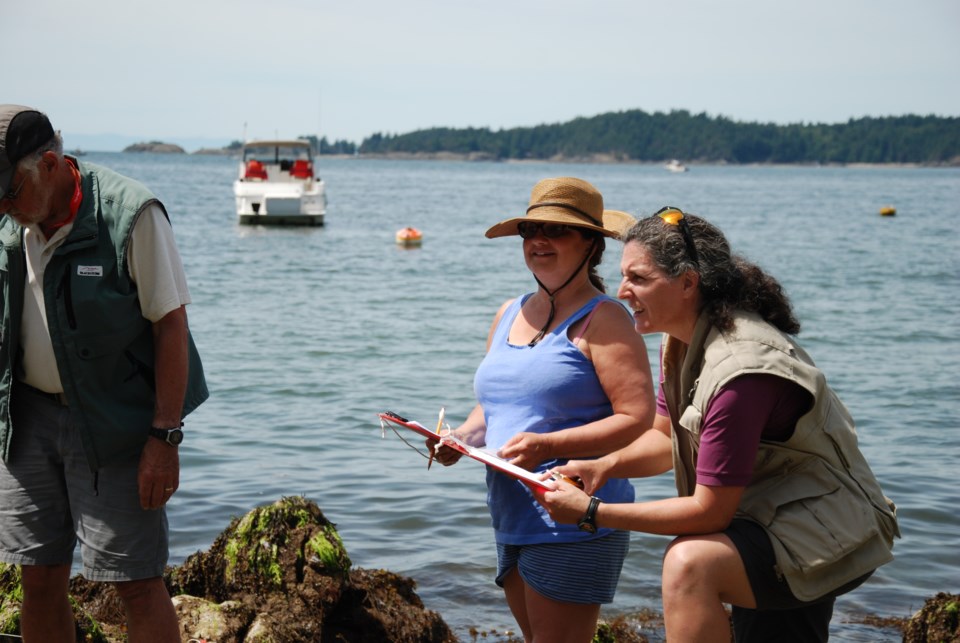LOUISE LOIK
EDITOR
As a team poured over a grid created by strings stretched out above the rocks on Tunstall Bay Beach, the researchers and volunteers made a great discovery.
After a horrifying die-off of sea stars in what was called a state of marine ecological emergency a few years back, the researchers had good news. There are still sea stars in the bay and there has been some recovery in the marine life.
Researcher Shannon Bard says that the group didn’t see any sea stars with wasting disease, which turned the animals, limb by limb, to mush.
On Saturday afternoon, as the tide pulled away from the headland, the group counted a small number of adult sea stars. Because the disease was the most devastating to adult sea stars, any remaining adults managed to survive the disease, which was great news on Bowen’s shores. Most of the other sea stars were half the size of an adult or younger, says Bard.
Bard was on Bowen to do a follow-up to a study she began two decades ago, when she studied the impact of pulp mills along the North American coast in relation to dioxins and furans, the compounds that result from the paper bleaching process. Now, with cleaner technology at mills and with some of the earlier mill sites Bard tested shut down, she is seeing some dramatic improvements to ecosystems.
“Since 1990 there have been increases in species and diversity overall,” she says. “Howe Sound is recovering, but not at the rate of some other areas like Powell River where marine life tripled after closure of a mill.”
She notes that she doesn’t have historical data for Tunstall Bay or Howe Sound, so it is hard to know what a fully recovered region would look like, but the area is still in recovery.
It will be a while before the hard data is in and analyzed and Bard says that tests for dioxins and furans are still very expensive per sample. Tests for metals are less expensive, making it easier to test for metals and mercury mined along the coast. Bard says that even without the data she can see something else that represents good news.
“It is most interesting that there was a large number of red rock crabs in addition to the purple sea stars,” says Bard.
Bard adds words of caution for parents of little beach explorers who may find the sea stars and red crabs.
“It’s important that people understand beach etiquette. It’s also important that kids don’t pick up a species from one zone, like a low-tide zone, and then leave it in a high-tide zone, or take something from a low-tide area and leave it to dry out in a high-tide zone,” she explains.
Each animal needs to be returned to its original location, and within a short time frame, as soon as possible. Bard also asks that people rolling rocks away to look for crabs return the rocks facing the same side down as before, being careful not to crush the animals, and to leave the habitat under the rock the same as before.
There have been other unusual marine life sightings, says Bob Turner, a local naturalist who is also a long distance ocean swimmer. He notes the sudden appearance of large schools of northern sardines that may be attracting predators. Turner says there is even a report of a humpback whale catching sardines by Tunstall Bay last week. There have also been more sightings of sea lions close to shore and on one south-side dock.
Bard says there is a lot of complexity around the recovery of a species. The top of the food chain is impacted from what goes on at the bottom of the food chain. Missing sea stars allow for proliferation of other species that impacts kelp beds, which impacts small fish that impacts bigger fish and then marine mammals.
“With invertebrates, we want to do things that will help the recovery of a species not to get stalled out,” she says.
Sometimes that means rebuilding shoreline habitat or introducing larvae to a site or adults from a species. On Tunstall Bay Beach, however, there has been no local intervention, just pollution controls.
Bard notes that the number of individuals has increased 50 per cent.
She adds that the biodiversity has a ways to go before reaching its full potential, though it is difficult to know what that level may be.
For now, the red crabs and purple sea stars are making headway on the road to recovery.
Marine scientist



